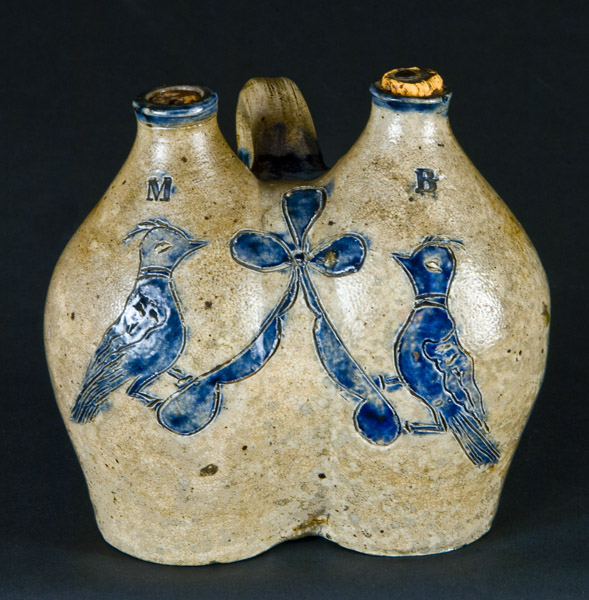Gemels
The pottery form known as a gemel, also gemel jug or gemel bottle, is one of the rarest forms in American stoneware. The word is derived from the Latin word “geminus,” meaning twin, double, paired, or half-and-half. The plural of this same word, “gemini,” is used to refer to the constellation composed of twin brothers, Castor and Pollux, of Greek mythology. The words “twin” or “double” definitely come to mind when one thinks of a pottery gemel, which is composed of two wheel-thrown jugs, joined together with clay between the two. A single handle is applied to carry and pour the paired jugs, though the positioning of this handle can vary from potter to potter. Variations of the form were also produced by American glass makers. Occasionally, the form is taken one step further, involving four connected jugs. Such pieces are referred to as “double gemels.”
The purpose of a gemel was to hold two liquids that were frequently used together in individual chambers. The form obviously made using such liquids more convenient than carrying two separate jugs. It is believed that many gemels were designed to hold oil and vinegar, which were commonly used in foods together, but needed to be kept separate. In other instances, a gemel may have held two different types of liquor.
While many gemels exist bearing little or no decoration, some are known with wonderful brushed or incised designs, indicating they were likely made as specially-ordered or presentation items. Most signed or attributed stoneware examples were produced in New Haven, Connecticut, by Absolom Stedman, or during Stedman’s partnership with one of the Seymours, around the year 1831 (Ketchum, American Stoneware, p. 58). Several are known bearing maker’s marks from this pottery, including some with distinctive incised bird designs accented with impressed circles.
Redware examples are also known from elsewhere in the country, including a few produced in the Shenandoah Valley of Virginia, which are pictured in H.E. Comstock’s The Pottery of the Shenandoah Valley Region. A small example by the highly-regarded potter, Anthony Bacher, who worked in Adams County, Pennsylvania, Winchester, Virginia, and Thurmont, Maryland, circa 1850 to 1885, is glazed in cream and brown and features a horizontal handle. A gemel by Winchester and Strasburg, Virginia potter, Solomon Bell, consists of two molded male figures holding mugs. Clay hats serve as the containers’ lids. Gemels were no doubt produced in nearly every region of 19th-century American utilitarian pottery production, though few have survived.

A stoneware gemel with incised and cobalt-highlighted birds and initials. (p4A item # D9732780)
Information courtesy of Crocker Farm http://www.crockerfarm.com, from a July 2009 blog posting on http://www.crockerfarm.com/blog/
Further Recommended Reading
American Stoneware by William C. Ketchum
